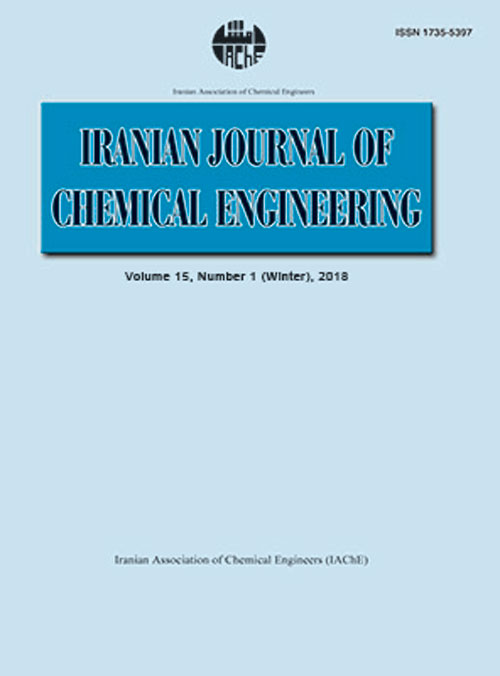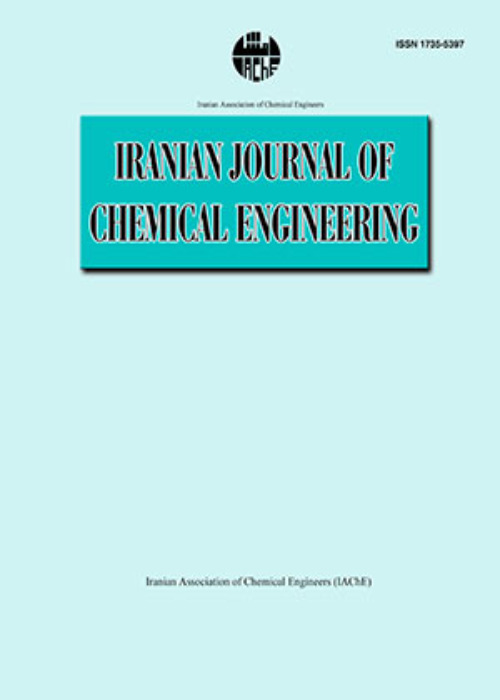فهرست مطالب

Iranian journal of chemical engineering
Volume:15 Issue: 1, Winter 2018
- تاریخ انتشار: 1396/12/28
- تعداد عناوین: 6
-
-
Pages 1-17Gas to liquid (GTL) process involves heterogeneous catalytic chemical reactions that convert synthesis gas to hydrocarbons and water vapor. A three phase reactor, called Low temperature Fischer-Tropsch (LTFT) is commonly applied for GTL process. In this reactor the gaseous phase includes the synthesis gas, light hydrocarbons and water vapor, the liquid phase is a mixture of the heavy hydrocarbons, and the solid phase is composed of the catalyst and the waxy products. The presence of the liquid phase in LTFT reactor causes mass transfer restriction, affecting the reaction conversion. In this work a numerical simulation of the LTFT fixed bed reactor in trickle flow regime has been accomplished to understand the impact of the liquid phase on the reactor performance. For this purpose, we have developed an axisymmetric two-dimensional multiphase heterogeneous model, where contain carbon monoxide and hydrogen, are transferred into the liquid phase. The reactor consisted of a shell and a tube that was filled with the spherical cobalt catalyst. The reaction conditions were as follows: the wall temperature was 473 K, pressure was 20 bars and a gas hour space velocity (GHSV) was 111 Nml.g_cat^(-1).h^(-1). The numerical simulation results proved the negative impact of the liquid phase on the reaction conversion. The model predictions were evaluated against the reported experimental data and also compared with the result of a numerical pseudo-homogeneous model. It was found that applying the heterogeneous model instead of the pseudo-homogeneous model clearly decreases the deviation of the numerical results.Keywords: LTFT synthesis, Fixed bed reactor, mass transfer restrictions, 2D, multiphase heterogeneous model, numerical simulatio
-
Pages 18-34In this study, the effects of some factors on bacterial growth and ferrous oxidation rates were investigated by Acidithiobacillus ferrooxidan in 250 ml shake flasks. One factor at a time (OFAT) design approach was used for preliminary evaluation of various factors affecting the process, such as pH, initial ferrous and elemental sulfur concentrations, shaker agitation rate, and liquid to flask volume ratio. After that, optimal levels of effective last three factors to achieve high oxidation rate and cell growth rate were investigated using a full factorial design. It was obtained that agitation rate and liquid to flask volume, as well as their binary interaction, are significant factors on ferrous iron bio-oxidation rate. In contrast, initial high ferrous iron concentration was the only effective factor on the cell growth rate. Maximum bio-oxidation rate of 0.417 g/L was achieved at the media with Fe2 ion concentration of 30 g/l, agitation rate of 200 rpm, and liquid to flask volume ratio of 20% by full factorial optimization, which is an about 40% increase compared to the result obtained in OFAT method. Then, the effect of step-wise adaptation of A. ferrooxidans to in high Fe2 concentration was studied, and about 40% reduction in bacterial lag phase time, and 36 and 86% increase in bacterial growth rate and bio-oxidation rate were acquired, respectively.Keywords: Biological oxidation_Ferrous sulfate_Acidithiobacillus ferrooxidans_Full factorial Design_One factor at a time
-
Pages 35-48The Lattice Boltzmann Method is used to simulate the dynamics of droplet deformation in a channel flow under various conditions. The droplet behavior has been investigated under transient conditions. For cases where the droplet remains attached to the surface, the shape deformation of the droplet during crawling is captured. It has been shown that there is a limiting value for the droplet volume beyond which the critical shear rate remains almost constant and does not demonstrate much correlation with the size of the droplet. The predicted shapes of the droplet at various stages of deformation in the course of the flow by the current LBM code demonstrates more resemblance to the reported experiments than those obtained by a traditional CFD code. The effect of the droplet's initial volume and Reynolds number on the detachment and crawling processes are also investigated. The results are presented at various time steps to better demonstrate the droplet separation. Under the flow conditions investigated, wherever the Aniline droplet detaches, the entire droplet separates from the surface. For an Isoquinoline droplet however, once the main body is detached, a small part of the droplet remains attached to the surface in flows with low Reynolds numbers.Keywords: Lattice Boltzmann Method, Multi, Component Fluid, Droplet Behavior, Critical Shear Rate, Capillary Number, Detachment, Crawling
-
Pages 73-88This paper describes a laboratory method for treatment of used engine oil FENIX SUPERIOR SAE 15W-40 with intention to decrease of sulfur and selected metal content at acceptable level. FENIX SUPERIOR SAE 15W-40, produced by manufacturer Joint Stock Company FAM Krusevac, is used for lubrication of the most modern four-stroke diesel and gas engines of passenger and commercial vehicles, engine construction, mining and agricultural machinery, as well as stationary power aggregates including highly overloaded engines working in harsh environmental conditions. Exhausted oil samples was obtained from the three sources: diesel and gas engines of passenger cars and agricultural machines tractors were treated according to novel two step technology. In first step physical operations such as centrifugation, filtration and separation was applied in order to remove mechanical impurities (sludge), condensed material and water. In the second step chemical oxidation, using three agents: hydrogen peroxide, sodium hypochlorite, and potassium persulfate was applied to achieve removal of the sulfur containing compounds. Based on obtained results at laboratory level, a technology at semi-industrial level for the treatment of waste oil was proposed. New ecologically friendly technology developed for treatment of waste oil offer appropriate advantages in comparison to commercially available technologies.Keywords: waste treatment, oil, removal of sulfur, sodium hypochlorite, additives
-
Pages 89-101One of the most appropriate methods for elimination of trace impurities in helium is cryogenic adsorption process. So, in this study design and construction of cryogenic adsorption helium purification system (3 Nm3.hr-1, 80 bar) carried out using activated carbon as adsorbent at 77K. To evaluation of adsorption dynamics and effect of pressure on elimination of trace impurities, helium purification was performed from 10 to 70 bar. Results showed that helium can be purified from 99.95 % to 99.99999% at pressure of 60 bar using cryogenic adsorption process. Effect of regeneration condition on helium purity and recovery was investigated by three different regenerationMethodsregeneration by helium at 40 °C and at 180 °C as purge gas, countercurrent to feed direction, and regeneration via vacuum. Results showed that regeneration of bed by vacuum can be proposed as most appropriated method because of maximum helium purity and high recovery of helium (98%).Keywords: Helium purifIcation, Cryogenic adsorption process, Regeneration condition, Activated carbon
-
Pages 102-114In the present study, Choline hydroxide (ChOH) as an ionic liquid catalyst was used for transesterification of soybean oil into biodiesel in a microchannel reactor. The effects of three variables i.e. reaction temperature, catalyst dosage and total flow rate on fatty acid methyl ester (FAME) content (wt. %) were optimized using BoxBehnken experimental design. In order to predict the FAME content a quadratic polynomial model was obtained. The optimal conditions from the model were reaction temperature of 53.53 °C, catalyst dosage of 2.6 wt. % and total flow rate of 11.82 mL/min. At these conditions, the predicted FAME content was 96.45 wt.% and the experimental FAME content was obtained 97.6 wt. %. The proximity of the experimental results and predicted values showed that the regression model issignificant. Using the ionic liquid catalyst in the studied microreactor for transesterification leads to diminish the reaction time to the order of seconds compared to conventional batch systems. In addition, the reusability of ChOH catalyst was investigated. The results revealed that the catalyst had perfect utility after several runs without much loss in the activity.Keywords: Biodiese, Ionic liquid, Transesterification, Microchannel, Soybean oil


